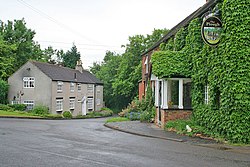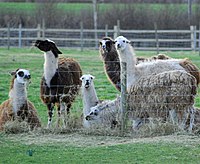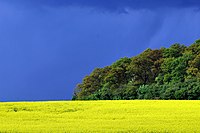Normanton-on-the-Wolds
| Normanton-on-the-Wolds | |
| Nottinghamshire | |
|---|---|

| |
| Location | |
| Grid reference: | SK622329 |
| Location: | 52°53’24"N, 1°4’34"W |
| Data | |
| Population: | 245 (2011) |
| Post town: | Nottingham |
| Postcode: | NG12 |
| Dialling code: | 0115 |
| Local Government | |
| Council: | Rushcliffe |
| Parliamentary constituency: |
Rushcliffe |
Normanton-on-the-Wolds is a small village in south-eastern Nottinghamshire: a place with a population of just 245 recorded at the 2011 census.
The name "Normanton" means 'Norseman's village;[1] a name given to several settlements in Midlands. The suffix "on the Wolds" distinguishes it from others, and reflects the village's position and in the Nottinghamshire Wolds.
This is a small village, six miles south-east of Nottingham very close to the village of Plumtree with which it has been associated, ecclesiastically and civilly, throughout its history.
The main street through Normanton was once the main road route from Nottingham to Melton Mowbray but was bypassed in 1930 by the road which is now the A606, passing just to the south of the village. The housing off Clipston Road and The Leys to the north of the village is accordingly only accessible, by vehicle, by driving onto, and shortly thereafter off the busy A606. This seclusion within a very short distance of a major road, along with the presence of many houses set in their own grounds, protected by red brick walls and mature trees and hedgerows, along the length of the village makes the south end of the village a particularly attractive place.
Although the village is essentially constructed along the old Melton Road, it has a Back Lane. The village consists of more exclusive homes including substantial manor houses, converted cottages and farm houses with many a large garden and long driveway.
Churches
There is no church in the village and instead the village is within the parish of Plumtree, and its church, St Mary the Virgin. This ancient church is believed to be one of the oldest churches in Nottinghamshire.[2]
Plumtree Methodists built a chapel in the village in 1797 (which was enlarged in 1827) but is now a private dwelling.
About the village
There are no shops, nor any other modern facility in Normanton, the inhabitants relying on mobility to reach nearby Tollerton, Keyworth, Cotgrave or other sources for their supplies. There are, however, businesses such as the working Avenue Farm providing stabling. Also the Ives family's Rushcliffe Breeders farm to the north of the village keeps a small, but conspicuous, herd of llamas.[3]
One of the better-known buildings in the village is the Plough Inn; a substantial ivy clad country road inn with extensive gardens. This deservedly popular pub offers good cuisine and is very hospitable. Regular bus services between Nottingham and Melton Mowbray detour off the A606 to pass along Old Melton Road through the village
To the east of the village a pretty stream, straggled by timber footbridges, flows from the south and east off the Wolds toward the Trent. The land here is mainly agricultural and Green Belt designated. To the north and east towards nearby Tollerton, Clipston and Cotgrave is farmland which includes crop land as well as grazing for sheep and horses. The large woods less than a mile directly east are a plantation. There are extensive and well marked public footpaths in the area affording, especially on the well-used path over the Wold edge to Clipston and Cotgrave, impressive views over a large area of the city of Nottingham to the North West.
North of the village is the distinctive, partially wooded, Hoe Hill, which is visible for miles around and forms one of the most westerly outcrops of the Wolds' northernmost edge with the Trent Valley.
History
Anglo-Saxon burials have been found off the nearby A46, originally the Fosse Way Roman Road.
The domesday Book of 1086 records that the manor was held before the Conquest by Unfac. By the time of Domesday, it was held by Roger de Busli (c.1038 – c.1099), to whom was granted also the nearby Normanton on Soar and Normanton on Trent. De Busli is recorded in the Domesday Book as holding these lands, but he died without an heir, his son having died in infancyand in 1099 his lands were given to Robert de Belleme, who lost them in 1102 after leading a rebellion against King Henry I.
In 1154, seventeen acres of arable land in the parish were given by Simon of Keyworth to Haveholme Priory of Lincolnshire, though later this land passed into the hands of the Knights Hospitaller.
In 1530 at the dissolution of the monasteries, the lands of the Knights Hospitaller became crown property. In 1548 the estate was bought by Thomas Brende.
In 1790 the common fields were subject to inclosure. At this time there are 20 recorded dwellings in the village and around 1,000 acres of land. By the 1830s the village had grown to 33 dwellings.
In the Victorian Age, the railway came to Norrmanton, and a station was opened here, named Plumtree station although the station house is slightly nearer to the centre of Plumtree than it is to Normanton. The station closed to passengers as early as 1949.
Outside links
| ("Wikimedia Commons" has material about Normanton-on-the-Wolds) |
References
- ↑ Gover, J. E. B.; Mawer, A. & Stenton, F.M.: 'Place-Names of Nottinghamshire , Part' (English Place-Names Society, 1940)
- ↑ St. Mary the Virgin, Plumtree – University of Nottingham
- ↑ British Llama Breeders: The British Llama Society)



